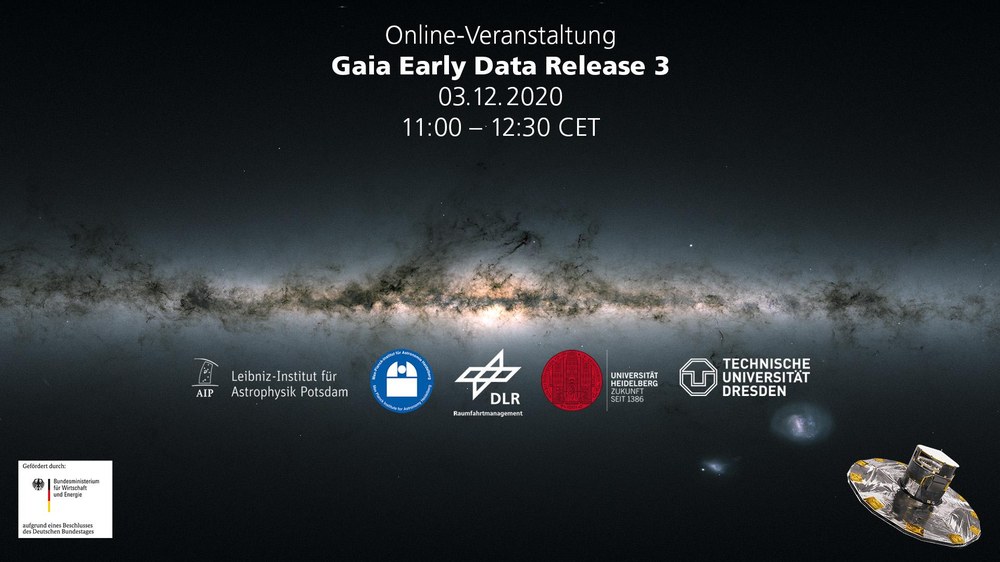Our galaxy in 3D: Gaia satellite mission maps the Milky Way



- The first instalment of the third data release of the Gaia star catalogue was published on 3 December 2020.
- The entire catalogue so far contains data on 1.8 billion celestial bodies. Proper motion and distance measurements for the majority of these – approximately 1.5 billion bodies – have now been significantly improved.
- On average, Gaia observes 850 million objects every day, equivalent to 20 gigabytes of data.
- Focus: Space, Big Data
The Gaia mission is engaged in an ambitious project – the creation of the most extensive and accurate star catalogue of all time. The first instalment of the catalogue’s third data release – the Gaia Early Data Release 3 (Gaia EDR3) – was published on 3 December 2020. “This marks another step towards our objective of completing a high-precision, three-dimensional optical survey of the entire sky,” says Walther Pelzer, Member of the German Aerospace Center (Deutsches Zentrum für Luft- und Raumfahrt; DLR) Executive Board and Head of the DLR Space Administration. “Gaia is gathering information on the positions and velocities of approximately two billion objects in the Milky Way and distant galaxies. It has already proven itself extremely successful at this task so far. With a total data volume of around one petabyte, Gaia will also help to strengthen the expertise of German academia and industry in the fields of Big Data processing, machine learning and artificial intelligence, as well as providing us with entirely new insights into the number, composition and distribution of stars and other celestial bodies.”
Improved data quality facilitates progress in space research
The aim of Gaia, which launched in December 2013, is to determine the position, proper motion, distance and brightness of almost two billion celestial bodies – including roughly one percent of the stars in our Galaxy. These are important parameters for determining the nature of objects and how their properties evolve over time. At the same time, this information is being used to create a three-dimensional star map with an unprecedented level of accuracy. “The first two data releases were published in September 2016 and April 2018 and have had a lasting impact on our understanding of the Milky Way’s development,” explains Alessandra Roy, Gaia Project Manager at the DLR Space Administration. “So far, 1.8 billion celestial bodies are listed in the combined data catalogue. Measurements relating to the proper motion and distance of the majority of these bodies – approximately 1.5 billion of them– have now been significantly improved.”
The first instalment of the third data release contains information about fainter stars in the vicinity of the Sun, areas in the outer regions of the Milky Way and stars in the Magellanic Clouds. It also features measurements of our Solar System’s acceleration relative to the rest of the galaxy. The quality of this new data is so high that scientists expect further advances to be made in research into the structure, dynamics and history of the Milky Way, and the wider study of the Universe as a whole.

Gaia Early Data Release 3
Your consent to the storage of data ('cookies') is required for the playback of this video on Youtube.com. You can view and change your current data storage settings at any time under privacy.
Big Data – essential for modern astronomy
The field of astronomy concerned with measuring and calculating the positions and motions of celestial bodies is called astrometry. It dates back over 5000 years, but it was only with ESA’s Hipparcos satellite in the 1990s, and now with Gaia in particular, that precision astrometry has begun. In order to produce the final Gaia catalogue, scientists have to simultaneously solve around ten billion equations and process over a petabyte of data. If the data in this catalogue were to be printed, the collection of books required to hold it would form a pile 100 kilometres high. On average, Gaia observes 850 million objects and produces 20 gigabytes of data every day.
Originally, the Gaia mission was scheduled to end in 2019. However, as all of the onboard instruments are still fully functional, the aim now is for the mission to continue gathering data until 2025. By this time, its supply of gas, which it uses to align itself, is likely to have been completely used up. The more extensive publication of the third Gaia Data Release (Gaia DR3) is scheduled for the first half of 2022. “In all likelihood, it will be a long time before we see a space mission comparable to Gaia,” says Roy. “At the moment, scientists are conducting studies with a view to designing an astrometry mission that also covers the infrared region of the electromagnetic spectrum, but the technology required for this has not yet been adequately developed.”
Over 20 countries cooperate on the Gaia mission
Gaia is a European Space Agency (ESA) mission involving over 20 countries, including Germany. Germany leads the coordination unit responsible for determining the astrometric results as part of the Gaia Data Processing and Analysis Consortium (DPAC). The German contribution, which is financed by the DLR Space Administration with funding from the German Federal Ministry for Economic Affairs and Energy (BMWi), involves the Astronomical Calculation Institute (University of Heidelberg), the Leibniz Institute for Astrophysics Potsdam, the Max Planck Institute for Astronomy (Heidelberg) and the Lohrmann Observatory at TU Dresden. The DLR Space Administration acts as the German national space agency. The Max Planck Institute for Astrophysics (Garching) will be involved in spectroscopic data analysis for the third data release. Hamburg Observatory and the University of Bremen were also involved in the first data release of the catalogue.
You can find additional material on Gaia here:
Livestream
You can watch the livestream of the Gaia event on 3 December 2020, from 11:00 to approximately 12:30, on the #EDR3 special page and ask questions to the experts involved
Software
With the free ‘Gaia Sky’ software, you can go on your own stellar journey:
